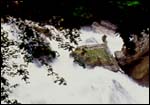


|
|
 |
| HOME | TRAVEL | TRAVELOG | ||

Vale of the Gods ... trekking in the Himalayas Sashi Kodasseri One day I'm sitting in a bar in Bombay with nothing to do but drink and watch others around me touch unreal heights as they got inebriated. And the next thing I know, I've got two tickets to New Delhi, photographer Arun K in tow, very little money in the pocket and we head out of town. We just wanted to get away, in the general direction of the Himalayas from Delhi. But our train took a detour towards Agra as there was a major train mishap along the Bombay-New Delhi route. So we hopped off at Agra and headed towards Rishikesh, and then jumped into a bus for Joshimath, a ski resort at the foothills. The Valley of Flowers in the Garhwal Himalayas was our destination. It was getting dark and we stopped at Karnaprayag as the buses refused to go any further for fear of landslides. I was nervous and restless. All along the road to here we'd seen rocks and fallen scree.
The monsoon weather made the 1 degree air seem even colder. And then finding yourself in a damp icy room, overlooking the cold, wild frothing Alakananda river, in a strange place and not knowing what to expect for the rest of the journey can bring in a sense of desolation. The only consolation for me was the sight of a girl dancing joyously in a well-lit room on the other bank of the river, the small joys of haphazard travelling. We reached Joshimath at around 11 the next morning. From there we had to take a bus to the village of Govindghat at the foothills. From there it is a seven-hour, 15 kilometre steep uphill trek to Gangharia, 4 kms from the valley. Interestingly the resident population of the Gangharia is about 2,000 during the four months of the year, when the place is operational and its floating population is that many times more. But during the remaining eight months it is a ghost town as everyone migrates to warmer zones. And that includes the stray dogs and the kachars, the mules used for transport.
After endless cups of tea and sly gulps of the local rice beer chhang -- booze being banned here other than for army personnel -- to warm us, we took a walk around the village where all kinds of pilgrimage paraphernalia was on sale. The next day we headed out of the village, four kms uphill for the valley -- height: 3,900 metres, population: a variety of rare flowers and insects. We were the third entrants into the national park that morning which stands at one end of the valley, also called the Valley of the Gods, located not far from the Indo-Nepal border.
We wondered if we should take the chance and cross over. I moved first. Slowly, steadily. Tapping the mud to check for firmness. Tap, tap, tap. Like a blind man. The firm soil under foot, could probably take a fraction of the 75 kgs of flesh that was attempting crawl over. Have to move carefully, and quickly, I thought. My eyes were bulging with a kind of 'insane' alertness. There were a few other trekkers behind us -- a couple of young adventurers and a family consisting of a couple and old infirm men sitting in bamboo baskets, called kandis by the locals, tied to the foreheads and backs of coolies, who were shouting and frantically gesticulating at me to stop. Suddenly the mud under my feet began to crumble.
|
|
|
Continued
|
|
|
|
|
|
HOME |
NEWS |
BUSINESS |
CRICKET |
MOVIES |
CHAT
INFOTECH | TRAVEL | LIFE/STYLE | FREEDOM | FEEDBACK |
|